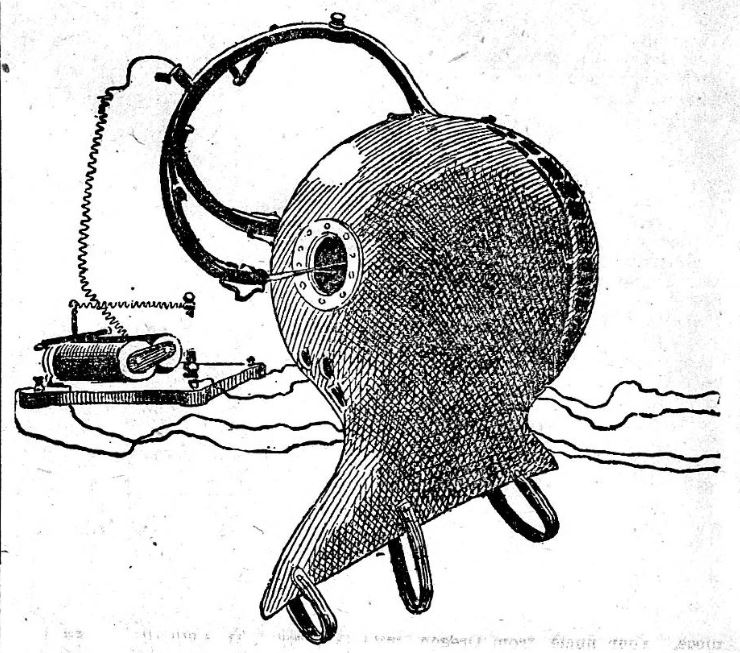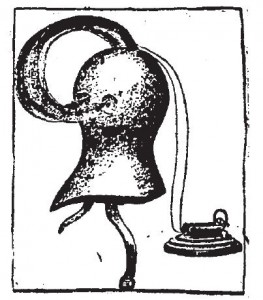Professor Esclangon’s Death Mask

The guillotine was hailed as a revolution in capital punishment. Seen as efficient, egalitarian, and painless compared with hanging, breaking on the wheel, or beheading with axe or sword, it performed its work tirelessly in the Place de la Revolution. However, unsettling anecdotes about blinking eyes, moving lips, and flushed cheeks gave rise to questions about whether Madame la Guillotine was as kind to the condemned as she might be. A Dr. Cinel claimed that the guillotined retained their senses for an hour after decapitation. [See “Instant Death by Decapitation an Impossibility According to Biological Analysis,” J. Mount Bleyyer, M.D. in The Medico-Legal Journal, Vol. 16, 1898 for a discussion of this theory.] Obviously there was still work to be done in the field of humane capital punishment.
TO TAKE THE GUILLOTINE’S PLACE
Whether or not the stroke of the guillotine causes instant death, it is more than likely that the raising of the question by Dr. Cinel will banish the machine which owes its origin to the reign of terror.
For months past the French government has had in its hand a machine superior to the guillotine in rapidity of action, which causes no distortion of visage and produces no scar. The machine, which has been named “L’Executioner” by its inventor, Francois Esclangon, a well-known scientist and the editor of the Parisian Le Monde Scientifique, is like the helmet worn by a fourteenth century cavalier. From the top curves a long, hollow bar of steel, dividing near its end into two portions, which approximate closely two holes in the helmet near the upper portion.
In the cavity of this bar are placed two cartridges, run on grooves made in the carved bar and attached to long, curved needles. In the helmet are two holes fitted with disks which can be made to revolve until they come into opposition with the eyes of the victim. The apparatus is in communication with a battery on a table near by which causes the cartridges to revolve and at the same time to plunge forward and bury themselves deep in the frontal lobes of the brain, destroying instantly a large portion of the white matter of the cerebrum.
Death is instantaneous and painless, and only a simple prick at the angle of each eye shows how the dead man passed.
The Princeton [MN] Union 22 December 1898: p. 6
Here is another artist’s conception of the “Death Mask,” as it was called in other newspapers, for example, the opening of this article in the Cincinnati Enquirer.
DEATH MASK
Suggested for Executions in Place of the Guillotine
[New York Journal.]
Prof. Esclangon, the editor of Le Monde Scientifique, in Paris, has invented a wonderful man killing machine, which he thinks will ultimately do away with the blood-stained and horrifying guillotine.
Although the death is effected by means of electricity, it is not altogether bloodless. The electrical part of the device is used simply for the purpose of pulling the trigger, so to speak, and setting the death-dealing machine to work.
The Cincinnati [OH] Enquirer 8 January 1898: p. 12

This sounds a nasty and probably ineffective way to perform an execution, although it was considerate of the inventor to think of not leaving a scar. Unless they were poisoned, needles through the eyes and into the brain seem survivable. This is, after all, roughly the method used in transorbital or “icepick” lobotomy and people like Phineas Gage have survived steel rods through the brain.
Any more information on this innovative execution method? Was it ever tested?
Make sure the electric battery is detached before sending to Chriswoodyard8 AT gmail.com
See these links for other novel methods of execution and articles on self-decapitation and guillotine inventors. (Do not try this at home.)
Chris Woodyard is the author of The Victorian Book of the Dead, The Ghost Wore Black, The Headless Horror, The Face in the Window, and the 7-volume Haunted Ohio series. She is also the chronicler of the adventures of that amiable murderess Mrs Daffodil in A Spot of Bother: Four Macabre Tales. The books are available in paperback and for Kindle. Indexes and fact sheets for all of these books may be found by searching hauntedohiobooks.com. Join her on FB at Haunted Ohio by Chris Woodyard or The Victorian Book of the Dead. And visit her newest blog, The Victorian Book of the Dead.
